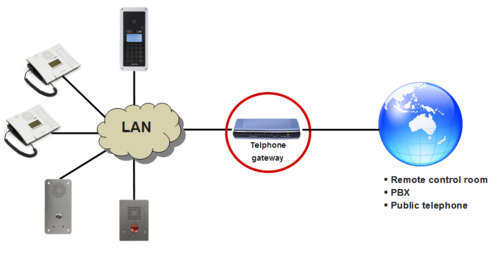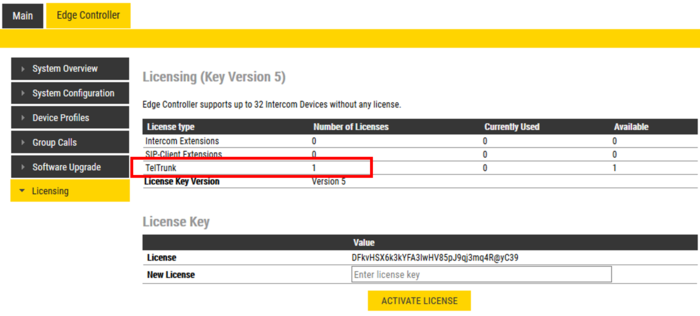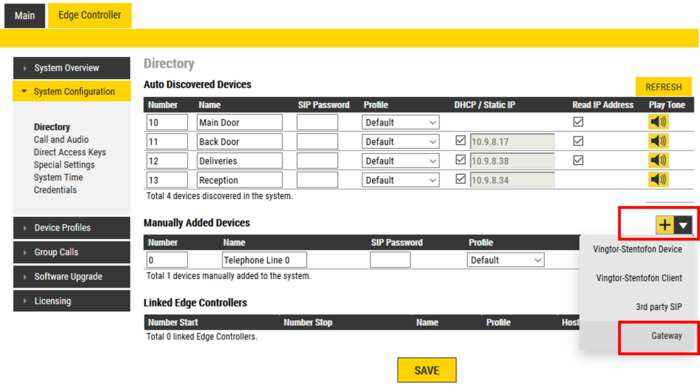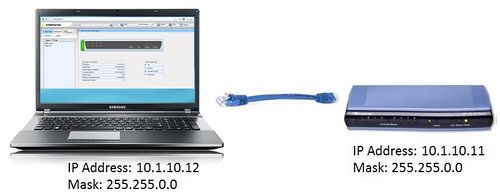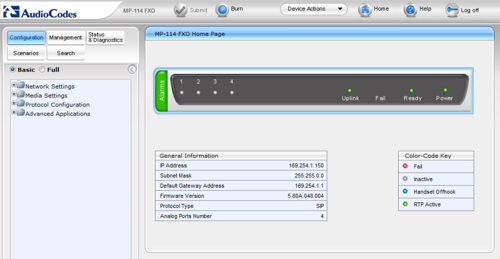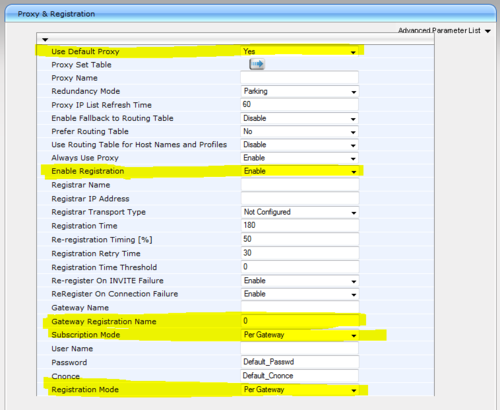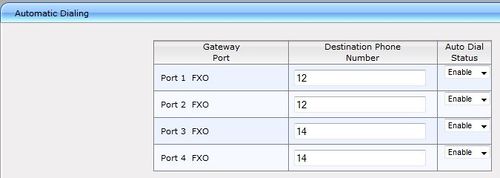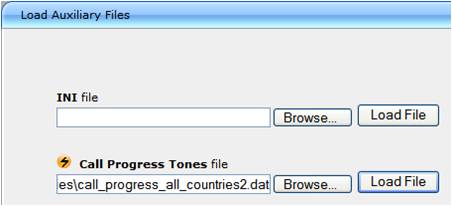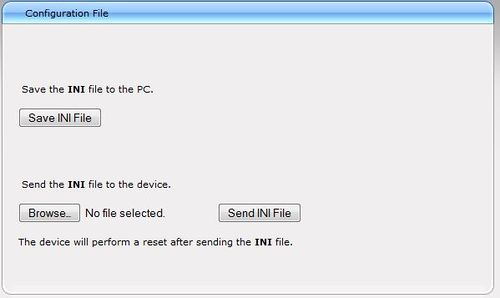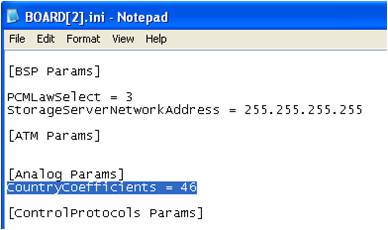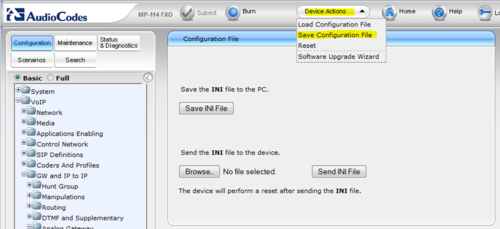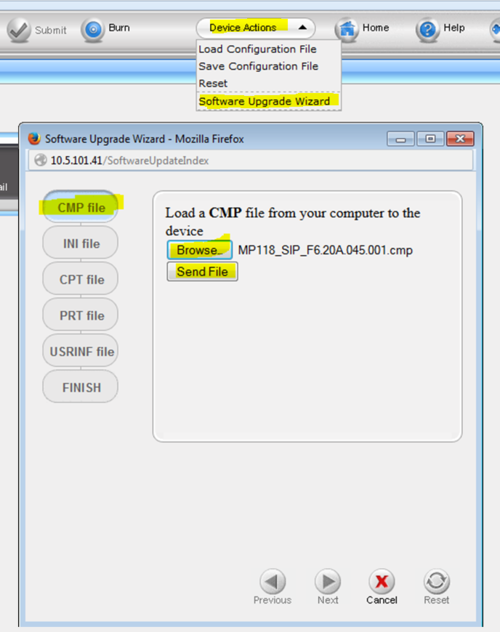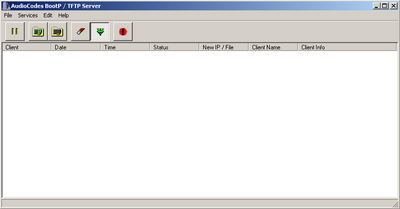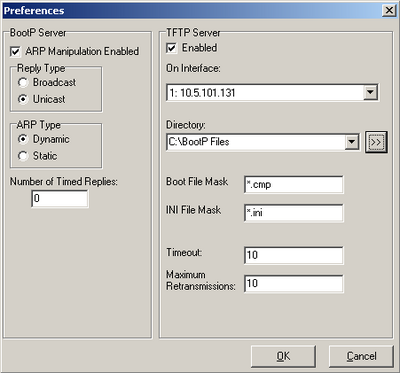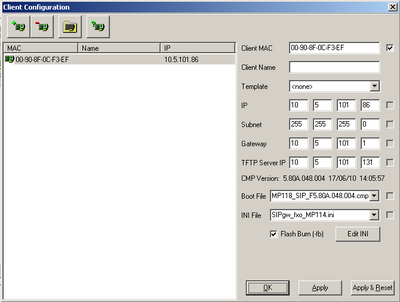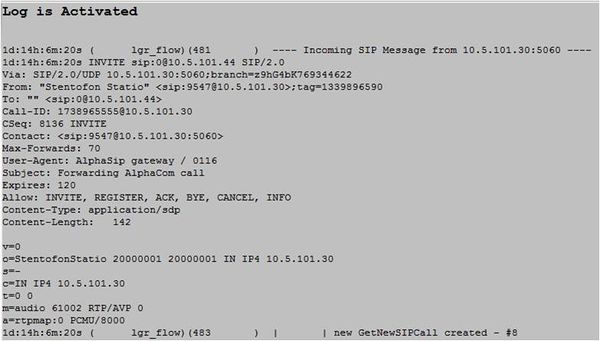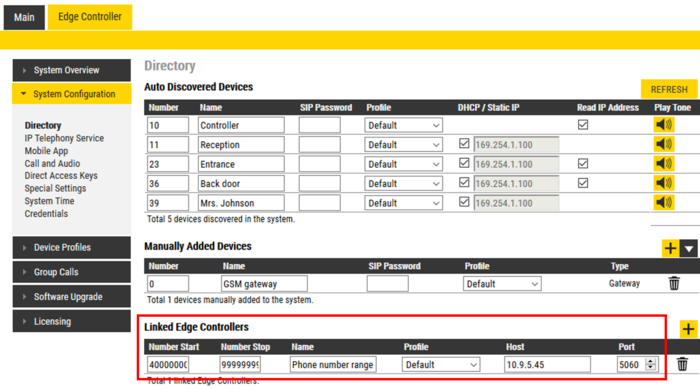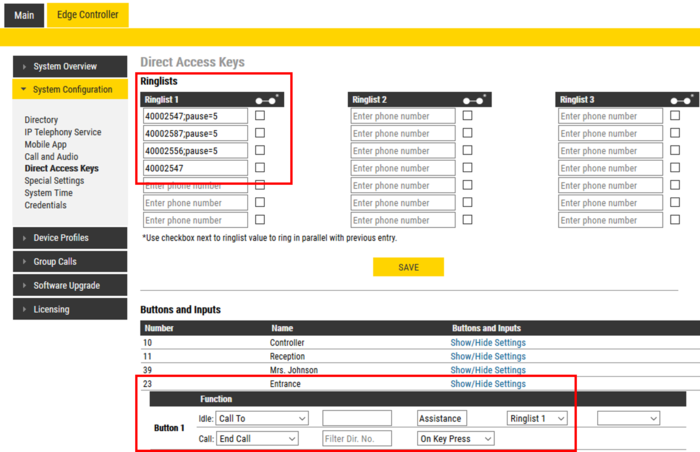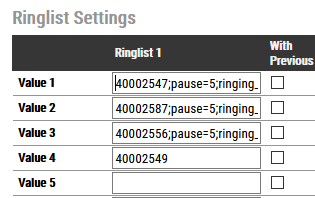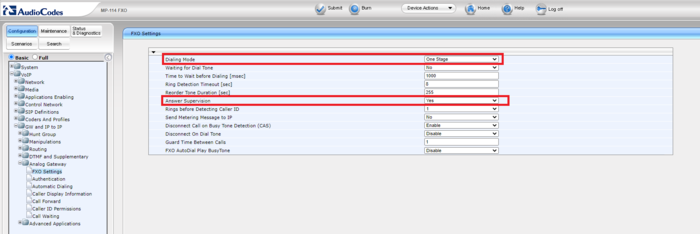AudioCodes MP114/118 (Edge): Difference between revisions
From Zenitel Wiki
| (One intermediate revision by the same user not shown) | |||
| Line 103: | Line 103: | ||
*'''Use Default Proxy''': Yes | *'''Use Default Proxy''': Yes | ||
*'''Enable Registration''': Enable | *'''Enable Registration''': Enable | ||
*'''Gateway Registration name''': 0 (This parameter must be identical to the directory number for the gateway defined in the | *'''Gateway Registration name''': 0 (This parameter must be identical to the directory number for the gateway defined in the Edge Controller) | ||
*'''Subscription Mode''': Per Gateway | *'''Subscription Mode''': Per Gateway | ||
*'''Registration Mode''': Per Gateway | *'''Registration Mode''': Per Gateway | ||
| Line 114: | Line 114: | ||
Click the '''Proxy Set Table''' button. Set the following parameters: | Click the '''Proxy Set Table''' button. Set the following parameters: | ||
*'''Proxy Address''': The IP address of the | *'''Proxy Address''': The IP address of the Edge Controller (e.g. 169.254.1.99). | ||
*'''Transport Type''': UDP | *'''Transport Type''': UDP | ||
* Press '''Submit''' to save changes | * Press '''Submit''' to save changes | ||
Latest revision as of 10:04, 18 January 2022
The IC-EDGE System can be connected to an analog PABX/PSTN line using the MP114/118 SIP gateway. This article describes the setup of the gateway in an IC-EDGE environment.
Prerequisites
- IC-EDGE System already installed
- AudioCodes MP114/118. Screenshots in this article is from firmware version 6.2.
Edge Controller configuration
Install license
The Telephone Gateway requires that there is a valid Telephone Gateway license installed.
To insert a license:
- Log on to the Edge Controller
- Select Edge Controller > Licensing
- In the New License field enter a valid license code, then Activate License
Create a SIP Account
A SIP Account must be created at the Edge Controller.
To add a new SIP account:
- From Edge Controller > System Configuration > Directory, under the Manually Added Devices section, press the "+" button
- Select Gateway from the dropdown list
- Number: 0. This is the number to dial to get access the telephone line. Other number can be used.
- Name: <name of your choice>
- Profile: Optionally one can change the Profile. Device Profiles are used if restrictions should be applied to Relay Activation (Door Opening), Group Call activation etc.
- Optionally one can add a SIP Password. If a password is entered, one have to also manually configure the same password in the gateway it self. The password is used for the registration proccess.
- Press Save to store the new device in the Edge Controller
Audiocodes MP-114/118 Configuration
Load Factory Default values
The AudioCodes MP-114/118 VoIP Gateway comes with default network parameters (factory default parameters). The default IP address is 10.1.10.11.
You can also load factory network parameters and reset the username and password to its default settings (username: Admin, password: Admin) by following these steps:
- Disconnect the Ethernet cable from the device
- With a paper clip or any other similar pointed object, press and hold down the Reset button (located on the rear panel) for about six seconds
- Release the Reset button. The red Fail LED turns on, and the device restores to factory default settings
- When the Fail LED turns off, reconnect the Ethernet cable to the device
- The VoIP Gateway will now get the IP address 10.1.10.11, subnet mask 255.255.0.0.
Accessing the gateway
- Change the IP address of your PC to 10.1.10.12, subnet mask 255.255.0.0.
- Connect the LAN port of the PC to the Ethernet port of the AudioCodes Gateway.
- Start your Web Browser and type 10.1.10.11 in the URL field.
- Type in username Admin and password Admin. (Case-sensitive!)
- The Home page of the Web Interface will appear:
Network Configuration
To change the IP address of the AudioCodes gateway, follow these steps:
- In the 'IP Settings' page (Configuration tab > VoIP menu > Network menu > IP Settings page item) enter the IP Address, Subnet Mask and optionally the Default Gateway Address of the AudioCodes Gateway.
- Click Submit to apply the changes.
Note: The IP address is immediately changed when pressing Submit, but it is not permanently stored. Without resetting or powering off the device, you need to log on to the Gateway using its new IP address in order to Burn the new IP address to flash:
- Change the IP address of your PC to match the new settings of the gateway. The PC and Gateway must be on the same sub-net.
- Re-access the Gateway using the new assigned IP address.
- Click the button Burn to permanently apply the changes.
IMPORTANT!
To prevent losing the configured IP address (and possibly other settings) due to DHCP request on gateway startup perform the following steps:
- Save configuration INI file to your PC (refer to Backup and Restore chapter for details)
- Open the INI file and position yourself inside [SYSTEM Params] section
- Add the following line to this section: BootPSelectiveEnable = 1
- Save the file and upload it to gateway (refer to Backup and Restore chapter for details)
Detailed information: The setting 'BootPSelectiveEnable = 1' enables the device's integral BootP client to filter unsolicited BootP/DHCP replies (accepts only BootP replies that contain the text 'AUDC' in the vendor specific information field). This option is useful in environments where enterprise BootP/DHCP servers provide undesired responses to the device's BootP requests.
SIP Parameters
Go to 'Proxy & Registration' page (Configuration tab > VoIP menu > SIP Definitions submenu > Proxy & Registration page item). Set the following parameters:
- Use Default Proxy: Yes
- Enable Registration: Enable
- Gateway Registration name: 0 (This parameter must be identical to the directory number for the gateway defined in the Edge Controller)
- Subscription Mode: Per Gateway
- Registration Mode: Per Gateway
- Press Submit to save changes
Click the Proxy Set Table button. Set the following parameters:
- Proxy Address: The IP address of the Edge Controller (e.g. 169.254.1.99).
- Transport Type: UDP
- Press Submit to save changes
Audio Codec
- Select the voice coder in 'Coders Table' page (Configuration tab > VoIP menu > Coders and Profiles submenu > Coders page item). Set these parameters:
- Coder Name: G.711U-law
- Packetization Time: 20 ms
- Rate: 64
- Silence Suppression: Disabled
- Press Submit to save changes
About Saving Changes
The Submit button will save the data to the running volatile memory. The changes take effect on-the-fly. The changes will not survive hardware reset or power off.
To permanently save the configuration data, store the data to flash memory by selecting Burn from the Tool Bar.
Note: Parameters proceeded by a yellow lightning symbol is not changeable on-the-fly and require that the device is reset.
Configure calls to outside lines
An outgoing call is made by dialing a prefix (e.g. "0") and then the phone number. If there are multiple lines connected to the gateway, the Group Hunt feature of the gateway will automatically connect the call to a free line.
1. In the Hunt Group Settings page, define Hunt Group ID 1 (Configuration tab > VoIP menu > GW and IP to IP submenu > Hunt Group submenu > Hunt Group Settings page item):
- Hunt Group ID = 1
- Channel Select Mode = Cyclic Ascending.
2. In IP to Trunk Group Routing page, route all calls from the Pulse system to Hunt Group ID 1. (Configuration tab > VoIP menu > GW and IP to IP submenu > Routing submenu > IP to Trunk Group Routing page item).
- Dest. Phone Prefix = *
- Source Phone Prefix = *
- Source IP Address = *
- Hunt Group ID = 1
- IP Profile ID = 0
3. In the Endpoint Phone Number Table page, you define how many outside lines to use, and link the lines (= Channels) to the prefix code (e.g. "0") and to the Hunt Group ID 1. (Configuration tab > VoIP menu > GW and IP to IP submenu > Hunt Group submenu > EndPoint Phone Number page item).
- Channel(s) = The outside line (1 - 4)
- Phone Number = 0 (Should be set identical to the Directory Number of the SIP account in the Pulse Server)
- Hunt Group ID = 1
In the example below all four lines belong to Hunt Group ID 1. When dialing 0 on an intercom station the first available line will be granted.
If there are unused lines, leave the fields for that line blank.
Dial external phone number when gateway is accessed
If you want to automatically call one fixed external phone number when the gateway is accessed from the Pulse system, you need to add a manipulation rule for outgoing calls.
First, ensure that on the "FXO Settings" (Configuration tab > VoIP menu > GW and IP to IP submenu >Analog Gateway submenu > FXO Settings page item) Dialing Mode parameter is set to One Stage.
After that, navigate to Configuration tab > VoIP menu > GW and IP to IP submenu > Manipulations submenu > Dest Number IP->Tel page item.
Click on the Add icon, a new dialog will pop up.
Do not change any parameters on the Rule tab. On the Action tab, change the following parameters:
- Stripped Digits From Left: should be the length of gateway directory number. I.e. if the directory number is "01" this value should be 2, and if the directory number is "0" this value should be 1.
- Prefix to Add: should be the actual telephone number you wish to dial.
Leave the other settings unchanged and click on Submit.
Configure incoming calls from outside lines
You can choose between three different ways of handling an incoming call from the telephone line:
- Selective Dialing
- Automatic Dialing
- Delayed Automatic Dialing
Selective Dialing
A second dial tone will be presented when calling in, and the user can dial the desired intercom number. The fields in the ‘Automatic Dialing’ page item must be left blank (This is the default setting). (Configuration tab > VoIP menu > GW and IP to IP > Analog Gateway submenu > Automatic Dialing page item).
In this mode the gateway collects digits from the line, and sets up the call towards the Pulse System when a predefined number of digits are collected and no more digits are received within a preset time (default 4 seconds), or when the ‘#’ key is dialed.
In the 'DTMF & Dialing' page (Configuration tab > VoIP menu > GW and IP to IP > DTMF and Supplementary submenu > DTMF & Dialing page item) set ‘Max Digits In Phone Num’ equal to the number of digits used in the directory number of the Pulse stations, normally 2 or 3. The parameter ‘Inter Digit Timeout [sec]’ specifies the waiting time for more digits before setting up the call.
Automatic Dialing
When calling in, the call will automatically be connected to a predefined intercom number.
- Enter the intercom number in the ‘Destination Phone Number’ field in the ‘Automatic Dialing’ page item. Set ‘Auto Dial Status’ to ‘Enable’. (Configuration tab > VoIP menu > GW and IP to IP > Analog Gateway submenu > Automatic Dialing page item).
In the example above, incoming calls on line 1 and 2 are routed to station 12, and calls on line 3 and 4 are routed to station 14.
Delayed Automatic Dialing
If ‘Auto Dial Status’ is set to ‘Hotline’, a second dial tone will be presented when calling in, allowing the user to dial a number. But if no digits are pressed within the ‘Hotline Dial Tone Duration’ time, the number in the Destination Phone Number is automatically dialed.
The ‘Hotline Dial Tone Duration’ can be changed from the 'DTMF & Dialing' page item (Configuration tab > VoIP menu > GW and IP to IP submenu > DTMF and Supplementary submenu > DTMF & Dialing page item). Display the Navigation Tree in Full View. The default value is 16 seconds.
Caller ID
The Caller ID is the text that will be shown in the display of a Pulse station when receiving an external phone call.
In the ‘Caller Display Information’ page you can define a default text to send to the intercom station that receives the call. (Configuration tab > VoIP menu > GW and IP to IP submenu > Analog Gateway submenu > Caller Display Information page item).
If Caller ID name is detected from the phoneline, this will be used instead of the Caller ID name in the table above. Display the Navigation Tree in Full View. Caller ID from FXO line must be enabled in Configuration tab > VoIP menu > GW and IP to IP submenu > DTMF and Supplementary submenu > Supplementary Services page item.
- Set ‘Enable Caller ID’ to ‘Enable’ and choose the ‘Caller ID Type’ as used by the PSTN supplier. Check with the local telephone company to find the ‘Caller ID Type’ used.
Far end disconnect (FED)
Far End Disconnect refers to methods for detecting that a remote party has hung up. The far end disconnect signal is not mandatory and this could create problems. If the Far End Disconnect signal is not sent to or properly detected by the SIP Gateway, the connection will not be released by the unit, thus freezing the FXO line in the off hook state.
The following methods for call termination are supported by the AudioCodes MP-114/118. Note that the used disconnection methods must be supported by the CO (Central Office) or to PBX (Private Branch Exchange).
- Detection of polarity reversal / current disconnect
- Detection of Busy / Dial tones
- Timeout of Conversation
- Detection of silence (NOT recommended, could lead to unwanted disconnection of calls)
Detection of polarity reversal / current disconnect
This is the recommended method. The call is immediately disconnected after polarity reversal or current disconnect is detected on the Tel side (assuming the PBX / CO produces this signal).
- Display the Navigation Tree in Full View. Enable the relevant detection method in Configuration tab > VoIP menu > SIP Definitions submenu > Advanced Parameters page item.
Detection of Busy / Dial tones
The call is immediately disconnected after Busy or Dial tone is detected on the Tel side (assuming the PBX / CO produces this tone). This method requires the correct tone frequencies and cadence to be defined in the Call Progress Tones (CPT) file of the SIP Gateway. If these frequencies are not known, define them in the CPT file (the tone produced by the PBX / CO must be recorded and its frequencies analyzed). This method is slightly less reliable than the previous one.
- Open the ‘FXO Settings’ page item in Configuration tab > VoIP menu > GW and IP to IP submenu > Analog Gateway menu > FXO Settings page item and enable the relevant detection method.
Call Progress Tones (CPT)
The Detection of Busy / Dial tones method requires the correct tone frequencies and cadence (on/off sequence) to be defined in the Call Progress Tones (CPT) file of the SIP gateway. These tones are region specific and telephone exchange dependent.
The Call Progress Tones (CPT) configuration file is a binary file (with the extension .dat).
You can either use:
- a CPT file with the most common tone patterns available from the download site
- one of the supplied CPT (dat) files found on the CD provided with the gateway
- construct your own file by adding new tones to the CPT file
Load a Call Progress Tones (dat) file to the SIP gateway:
- Select Management tab > Software Update menu > Load Auxiliary Files page item.
- Click the Browse button and navigate to the folder that contains the file you want to load
- Click the file and click the Open button; the name and path of the file appear in the field beside the Browse button
- Click the Load File button
- Burn the configuration so the file can be available after a power failure
- Reset the SIP Gateway for the changes to take effect
For more detailed information regarding Call Progress Tones please refer to the AudioCodes User's Manual found on the CD supplied with the unit.
Timeout of Conversation
As an additional safety to prevent lines from accidentally locking up, it is recommended to enable a timeout of conversation.
The ‘Max Call Duration’ defines the maximum call duration in minutes. If this time expires, both sides of the call are released (IP and Tel). The valid range is 0 to 120. The default is 0 (no limitation).
- Display the Navigation Tree in Full View. Enable the ‘Max Call Duration’ in Configuration tab > VoIP menu > SIP Definitions submenu > Advanced Parameters page item.
DTMF Input from outside line
During a conversation between a Pulse station and a telephone, the telephone operator can activate an output in the Pulse System by pressing a digit on the phone.
To enable digit actions from the telephone line during conversation, set ‘1st Tx DTMF Option’ to ‘INFO(Cisco)’ in the 'DTMF & Dialing' page. (Configuration tab > VoIP menu > GW and IP to IP submenu > DTMF and Supplementary submenu > DTMF & Dialing page item).
Country Settings
The Line Characteristics (AC impedance matching, hybrid balance, Tx & Rx frequency response, Tx & Rx Gains, ring detection threshold, DC characteristics) should be set according to country of origin. Some of the SIP Gateway parameters are configurable through the ini configuration file only (and not via the Web). The CountryCoefficients parameter that determines the line characteristics must be configured via the ini configuration file.
The procedure to modify the ini file:
- Get the ini file from the gateway using the Embedded Web Server. From the Tool Bar select Device Actions -> Save Configuration File. Select Save INI File to save the configuration to the PC:
- Open the file (e.g. in Notepad), and add anywhere in the file the line
CountryCoefficients = xx
- where xx is the country code found below; save and close the file. The example below shows the settings for Norway (46).
- Load the modified ini file back to the gateway using the button Browse to select the modified file, then select Send INI File.
This method preserves the programming that already exists in the device, including special default values that were preconfigured when the unit was manufactured.
Country codes
The default value is 70 (United States).
| Argentina | = 0 |
| Australia | = 1 |
| Austria | = 2 |
| Bahrain | = 3 |
| Belgium | = 4 |
| Brazil | = 5 |
| Bulgaria | = 6 |
| Canada | = 7 |
| Chile | = 8 |
| China | = 9 |
| Colombia | = 10 |
| Croatia | = 11 |
| Cyprus | = 12 |
| Czech_Republic | = 13 |
| Denmark | = 14 |
| Ecuador | = 15 |
| Egypt | = 16 |
| El Salvador | = 17 |
| Finland | = 18 |
| France | = 19 |
| Germany | = 20 |
| Greece | = 21 |
| Guam | = 22 |
| Hong_Kong | = 23 |
| Hungary | = 24 |
| Iceland | = 25 |
| India | = 26 |
| Indonesia | = 27 |
| Ireland | = 28 |
| Israel | = 29 |
| Italy | = 30 |
| Japan | = 31 |
| Jordan | = 32 |
| Kazakhstan | = 33 |
| Kuwait | = 34 |
| Latvia | = 35 |
| Lebanon | = 36 |
| Luxembourg | = 37 |
| Macao | = 38 |
| Malaysia | = 39 |
| Malta | = 40 |
| Mexico | = 41 |
| Morocco | = 42 |
| Netherlands | = 43 |
| New_Zealand | = 44 |
| Nigeria | = 45 |
| Norway | = 46 |
| Oman | = 47 |
| Pakistan | = 48 |
| Peru | = 49 |
| Philippines | = 50 |
| Poland | = 51 |
| Portugal | = 52 |
| Romania | = 53 |
| Russia | = 54 |
| Saudi_Arabia | = 55 |
| Singapore | = 56 |
| Slovakia | = 57 |
| Slovenia | = 58 |
| South_Africa | = 59 |
| South_Korea | = 60 |
| Spain | = 61 |
| Sweden | = 62 |
| Switzerland | = 63 |
| Syria | = 64 |
| Taiwan | = 65 |
| TBR21 | = 66 |
| Thailand | = 67 |
| UAE | = 68 |
| United_Kingdom | = 69 |
| UnitedStates | = 70 |
| Yemen | = 71 |
Backup and Restore
The configuration of the AudioCodes Gateway can be stored to a file on your PC.
- Backup: From the Tool Bar select Device Actions -> Save Configuration File. Select Save INI File to save the configuration to the PC
- Restore: From the Tool Bar select Device Actions -> Load Configuration File. Browse to the ini-file, and select Load INI File to upload the configuration file to the SIP Gateway. The gateway will restart after the upload.
Software Upgrade
To upgrade the software of the AudioCodes MP114 gateway, follow these steps:
- From the Home Page of the Gateway, select Device Actions -> Software Upgrade Wizard
- Select the button CMP file, and Browse to the software file (.cmp), and select Send File.
- When the file is successfully loaded, press the Next button.
- You will now get a choice to "Use the existing configuration", load a new INI file, or load default settings to the unit.
- Make your choice, and press the Reset button when the process is finished.
Troubleshooting
Factory Reset by using BootP utility
If the factory reset for some reason seem to fail, and you end up with all LED's lit in the MP11x, then it is no longer possible to contact the MP11x using a known IP address. A possible rescue is to use the AudioCodes' BootP program. This program accesses the MP11x using its MAC address and uploads a selected firmware file (cmp) and configuration file (ini file).
The BootP program, the cmp-file and the ini-file can be downloaded from the download site.
- Install and run BootP
- Click Edit -> Preferences
- Set the TFTP server (your computer) and the directory where the firmware (.cmp) and .ini files are stored
- Click OK
- Click Service -> Clients
- Enter the MAC address and set the IP settings that you want the device to have. Also make sure that the boot file (firmware) and .ini file is selected
- Click Apply&Reset then OK
Message log
The 'Message Log' page displays Syslog debug messages sent by the device. You can select the Syslog messages in this page, and then copy and paste them into a text editor such as Notepad. This text file (txt) can then be sent to Technical Support for diagnosis and troubleshooting.
Note: It's not recommended to keep a Message Log session open for a prolonged period. This may cause the device to overload. For prolonged (and detailed) debugging, use an external Syslog server.
To activate the Message Log, take these 3 steps:
- In the 'Advanced Parameters' (Configuration tab > Protocol Configuration menu > SIP Advanced Parameters submenu > Advanced Parameters page item), set the parameter 'Debug Level' to 6. This parameter determines the Syslog logging level in the range 0 to 6, where 6 is the highest level.In newer firmware version this is set in Configuration tab > System menu > Syslog Settings page item.
- Open the 'Message Log' page (depending on your firmware version this will either beStatus & Diagnostics tab > Status & Diagnostics menu > Message Log page item, or Status & Diagnostics tab > System Status menu > Message Log page item). Now the 'Message Log' page is displayed and the log is activated.
The displayed logged messages are color coded as follows:
- Yellow - fatal error message
- Blue - recoverable error message (i.e., non-fatal error)
- Black - notice message
- To clear the page of Syslog messages, in the Navigation tree, click the page item Message Log again; the page is cleared and new messages begin appearing.
To stop the Message Log, take this step:
- Close the page by accessing any another page in the Web interface.
Call multiple phone numbers in sequence
The Ringlist in the Edge system can be used to call several phone numbers in sequence. If the first number doesn't answer within a preset time, the call will be made to the second number, and so on. Intercom stations can also be included in the sequence. You can have up to seven different numbers in the ring list when configuring the global ringlist from the Edge Controller. Alternatively one can configure the ringlist in the calling station it self, then there is room for 29 entries.
Call scenario examples:
- Call to an Intercom station > Phone number 1 > Phone number 2 in sequence, or
- Call Phone number 1 > Phone number 2 > Phone number 3 in sequence

|
|
Define the phone number range:
In the Edge Controller, Server Configuration > Directory, go to the Linked Edge Controllers section and define the number range for the phone numbers to call, and the IP Address of the MP114:
Configure Call Button and Ringlist:
In the Edge Controller, Server Configuration > Direct Access Keys, define in "Ringlist 1" the phone numbers to call. Add the expression ";pause=5" after each number to insert a pause of 5 seconds between each call. This pause is mandatory.
If there is a need to have different sequences for different stations, use "Ringlist 2" and "Ringlist 3", and configure stations to call via that ringlist instead.

|
The numbers in the ringlist should be entered without the number for accessing the telephone gateway (by default this number is zero) |
Ringing time:
The default ringing time is 60 seconds before it goes to the next in the sequence. If you need to change this time, you have to log on to the calling station it self:
- Log on to the calling station (not the Edge Controller)
- Enable Advanced Configuration Mode
- Go to Edge Configuration > Direct Access Keys. Scroll down to the bottom of the page, and set Ringing Time to the interval you want. This ringing time will apply to each step in the sequence.
- As an option, one can have individual ringing time on each entry by adding ";ringing_time=xx" after the entry, e.g.:
- Value 1: 40002547;pause=5;ringing_time=40
- Value 2: 40002587;pause=5;ringing_time=30
- Value 3: 40002556;pause=5;ringing_time=55
- Value 4: 40002549

|
The MP114 must be registered in the Edge controller in order to receive calls from the telephone network |
Set one-stage dialing and Answer Supervision:
When using sequential calls, the MP114 must be configured to use one-stage (Enbloc) dialing. Go to Configuration > Analog Gateway > FXO Settings.
- Set Dialing Mode to One Stage.
- Set Answer Supervision to Yes.
Submit the changes and then apply them by clicking Burn

